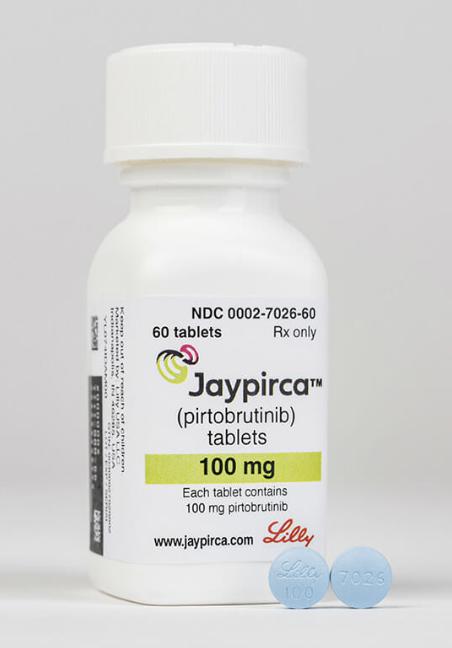Pirtobrutinib and Alcohol/Food Interactions
There is 1 alcohol/food/lifestyle interaction with pirtobrutinib.
Pirtobrutinib Food/Lifestyle
Major Food Interaction
GENERALLY AVOID: Grapefruit juice may increase the plasma concentrations of pirtobrutinib, which is primarily metabolized by CYP450 3A4. The proposed mechanism is inhibition of CYP450 3A4-mediated first-pass metabolism in the gut wall by certain compounds present in grapefruit. Inhibition of hepatic CYP450 3A4 may also contribute. The interaction has not been studied with grapefruit juice but has been reported for other CYP450 3A4 inhibitors. When pirtobrutinib (200 mg single dose) was administered with itraconazole, a potent CYP450 3A4 inhibitor, pirtobrutinib systemic exposure (AUC) increased by 49%. Concomitant use of diltiazem or verapamil, moderate CYP450 3A4 inhibitors, is predicted to increase pirtobrutinib AUC by 20% and 30%, respectively. In general, the effect of grapefruit juice is concentration-, dose- and preparation-dependent, and can vary widely among brands. Certain preparations of grapefruit juice (e.g., high dose, double strength) have sometimes demonstrated potent inhibition of CYP450 3A4, while other preparations (e.g., low dose, single strength) have typically demonstrated moderate inhibition. Increased exposure to pirtobrutinib may increase the risk of infection, bruising, bleeding, fatigue, musculoskeletal pain, diarrhea, edema, and dyspnea.
MANAGEMENT: It may be advisable for patients to avoid consumption of grapefruit, grapefruit juice, or supplements that contain grapefruit during treatment with pirtobrutinib.
References (1)
- (2023) "Product Information. Jaypirca (pirtobrutinib)." Lilly, Eli and Company
Switch to consumer interaction data
Pirtobrutinib drug interactions
There are 737 drug interactions with pirtobrutinib.
Pirtobrutinib disease interactions
There are 2 disease interactions with pirtobrutinib which include:
More about pirtobrutinib
- pirtobrutinib consumer information
- Check interactions
- Compare alternatives
- Reviews (6)
- Side effects
- Dosage information
- During pregnancy
- Drug class: BTK inhibitors
- Breastfeeding
- En español
Related treatment guides
Drug Interaction Classification
| Highly clinically significant. Avoid combinations; the risk of the interaction outweighs the benefit. | |
| Moderately clinically significant. Usually avoid combinations; use it only under special circumstances. | |
| Minimally clinically significant. Minimize risk; assess risk and consider an alternative drug, take steps to circumvent the interaction risk and/or institute a monitoring plan. | |
| No interaction information available. |
See also:
Further information
Always consult your healthcare provider to ensure the information displayed on this page applies to your personal circumstances.


